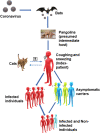SARS coronavirus 2: from genome to infectome
- PMID: 33261606
- PMCID: PMC7706175
- DOI: 10.1186/s12931-020-01581-z
SARS coronavirus 2: from genome to infectome
Abstract
Severe acute respiratory syndrome coronavirus-2 (SARS-CoV-2) belongs to the group of Betacoronaviruses. The SARS-CoV-2 is closely related to SARS-CoV-1 and probably originated either from bats or pangolins. SARS-CoV-2 is an etiological agent of COVID-19, causing mild to severe respiratory disease which escalates to acute respiratory distress syndrome (ARDS) or multi-organ failure. The virus was first reported from the animal market in Hunan, Hubei province of China in the month of December, 2019, and was rapidly transmitted from animal to human and human-to-human. The human-to-human transmission can occur directly or via droplets generated during coughing and sneezing. Globally, around 53.9 million cases of COVID-19 have been registered with 1.31 million confirmed deaths. The people > 60 years, persons suffering from comorbid conditions and immunocompromised individuals are more susceptible to COVID-19 infection. The virus primarily targets the upper and the lower respiratory tract and quickly disseminates to other organs. SARS-CoV-2 dysregulates immune signaling pathways which generate cytokine storm and leads to the acute respiratory distress syndrome and other multisystemic disorders.
Keywords: ACE2 receptors; Acute respiratory distress syndrome (ARDS); COVID-19; Coronaviruses; SARS-CoV-2; Spike glycoprotein.
Conflict of interest statement
The authors declare that they have no competing interests.
Figures



Similar articles
-
SARS-CoV-2 multifaceted interaction with human host. Part I: What we have learnt and done so far, and the still unknown realities.IUBMB Life. 2020 Nov;72(11):2313-2330. doi: 10.1002/iub.2380. Epub 2020 Sep 12. IUBMB Life. 2020. PMID: 32918855 Review.
-
SARS-CoV-2 Infection: New Molecular, Phylogenetic, and Pathogenetic Insights. Efficacy of Current Vaccines and the Potential Risk of Variants.Viruses. 2021 Aug 25;13(9):1687. doi: 10.3390/v13091687. Viruses. 2021. PMID: 34578269 Free PMC article. Review.
-
Therapeutic Measures for the Novel Coronavirus: A Review of Current Status and Future Perspective.Curr Mol Med. 2021;21(7):562-572. doi: 10.2174/1566524020666201203170230. Curr Mol Med. 2021. PMID: 33272178 Review.
-
SARS-CoV-2: Targeted managements and vaccine development.Cytokine Growth Factor Rev. 2021 Apr;58:16-29. doi: 10.1016/j.cytogfr.2020.11.001. Epub 2020 Dec 1. Cytokine Growth Factor Rev. 2021. PMID: 33293238 Free PMC article. Review.
-
Innate immunity in COVID-19: Drivers of pathogenesis and potential therapeutic targets.Asian Pac J Allergy Immunol. 2021 Jun;39(2):69-77. doi: 10.12932/AP-130121-1037. Asian Pac J Allergy Immunol. 2021. PMID: 34174806 Review.
Cited by
-
Identification of B-Cell Epitopes for Eliciting Neutralizing Antibodies against the SARS-CoV-2 Spike Protein through Bioinformatics and Monoclonal Antibody Targeting.Int J Mol Sci. 2022 Apr 14;23(8):4341. doi: 10.3390/ijms23084341. Int J Mol Sci. 2022. PMID: 35457159 Free PMC article. Review.
-
Peritoneal Administration of a Subunit Vaccine Encapsulated in a Nanodelivery System Not Only Augments Systemic Responses against SARS-CoV-2 but Also Stimulates Responses in the Respiratory Tract.Viruses. 2021 Nov 2;13(11):2202. doi: 10.3390/v13112202. Viruses. 2021. PMID: 34835008 Free PMC article.
-
Structural and functional insights into the spike protein mutations of emerging SARS-CoV-2 variants.Cell Mol Life Sci. 2021 Dec;78(24):7967-7989. doi: 10.1007/s00018-021-04008-0. Epub 2021 Nov 3. Cell Mol Life Sci. 2021. PMID: 34731254 Free PMC article. Review.
-
A Review of THz Technologies for Rapid Sensing and Detection of Viruses including SARS-CoV-2.Biosensors (Basel). 2021 Sep 22;11(10):349. doi: 10.3390/bios11100349. Biosensors (Basel). 2021. PMID: 34677305 Free PMC article. Review.
-
Prevalence and association of oral manifestations with disease severity in patients diagnosed with COVID‑19: A cross‑sectional study.Med Int (Lond). 2024 Apr 10;4(3):30. doi: 10.3892/mi.2024.154. eCollection 2024 May-Jun. Med Int (Lond). 2024. PMID: 38660127 Free PMC article.
References
-
- Zhong NS, Zheng BJ, Li YM, Poon, Xie ZH, Chan KH, Li PH, Tan SY, Chang Q, Xie JP, et al. Epidemiology and cause of severe acute respiratory syndrome (SARS) in Guangdong, People's Republic of China, in February, 2003. Lancet. 2003;362:1353–1358. doi: 10.1016/S0140-6736(03)14630-2. - DOI - PMC - PubMed
Publication types
MeSH terms
Substances
LinkOut - more resources
Full Text Sources
Medical
Miscellaneous

